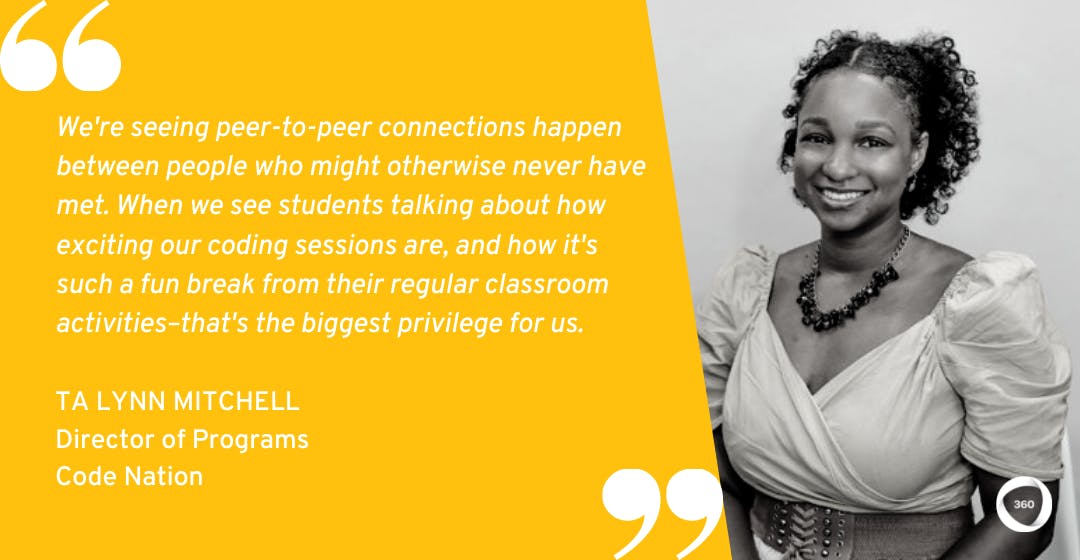Every day, all over the world, volunteers play a crucial role in supporting people, caring for others, and generally keeping the wheels turning. These volunteers come from a range of backgrounds, with different capabilities and strengths.
So, how can the organizations supporting these volunteers ensure they have the right training to make the biggest positive impact in their work? And more specifically, how can they help technical experts develop skills in new areas such as teaching or public speaking?
Recently, I had the pleasure to sit down with Ta Lynn Mitchell of Code Nation to talk about just that. As Code Nation’s Director of Programs, Ta Lynn provides volunteer coding teachers with the support they need to get young people interested in the world of coding–including supporting these teachers with Collaborative Learning.
We started our discussion by talking about the amazing work Code Nation is doing to inspire the next generation of coders.
Inspiring the next generation of coders
As Ta Lynn explains, Code Nation has a simple yet powerful mission.
“Our mission at Code Nation is to expose young students to coding, and to help them explore these career pathways,” she says. “We do that by bringing developers from the field into the classroom with the students. They’re teaching HTML, CSS, JavaScript, jQuery, and more.”
“We’re excited to expose our students to different career pathways, and in the long-term, to help them decide if they want to go into coding or not.”
Like many volunteers, some Code Nation teachers need additional training to help prepare them. “A lot of our developers don’t have a teaching background, so our job is to support them to develop these skills. That’s why we have program managers in the classroom who do come from a teaching background, and who have that pedagogy to help our teachers learn.”
For Ta Lynn and the rest of the Code Nation team, their work is always growing. “We started in New York City, and then we expanded to the Bay Area, where I currently am. We’re also in Chicago. We’re working with about 300 different schools in total across the country.”
“Here in the Bay Area, we’re working in about 30 schools, with about 200 or so volunteers. It’s a privilege to work with so many people from different backgrounds, including people from non-traditional tech backgrounds who have made their way into that field. Hearing their stories is a great way to encourage our students to get interested in coding.”
It’s a privilege to work with so many people from different backgrounds, including people from non-traditional tech backgrounds who have made their way into that field. Hearing their stories is a great way to encourage our students to get interested in coding.
Need a few more CLO Connect expert insights? Find out How L&D Can Help Your Company Scale
How Code Nation is facing the challenges of COVID-19
Like so many other organizations, Code Nation has faced some major challenges during the COVID-19 pandemic.
“2020 was a very unusual year, as it was for everyone,” says Ta Lynn. “We transitioned to being fully remote, which gave rise to a big challenge: how could we prepare our volunteers to get comfortable with the idea of teaching remotely? What are our best practices?”
“Unlike the workplace, remote engagement can be a little bit different in a classroom context. Some students don’t feel comfortable having cameras on, which can make things really difficult. It’s our job to make sure our volunteers feel ready to engage with students, whether they do it through messenger or whether they do it outside of class.”
Another element to this challenge? Some volunteers have moved out of the Bay Area permanently. “A lot of tech companies have gone remote indefinitely, so some of our volunteers have now moved away. This makes it critical for us to recruit and retain a strong workforce of volunteers, especially as we start to transition back into the classroom.”
Despite these challenges, Code Nation has continued to support its volunteer teachers to work with students. A major part of this support comes down to its 4-step learning approach.

Code Nation’s 4 steps to support teachers with Collaborative Learning
Code Nation is committed to introducing a new generation to the exciting world of coding. To do that, they recruit volunteers with the right kind of technical skills, then help them develop new capabilities in teaching, public speaking, and leading group interactions.
To support these volunteers to develop these capabilities, Code Nation uses a four-step approach based in the principles of Collaborative Learning.
1. Training volunteers in basic teaching pedagogy
“We have our initial three-day training during the summer, before school starts,” says Ta Lynn. “This is focused on making sure volunteers feel comfortable.”
“This training includes our basic pedagogy, starting with best practices for how to teach, and what is developmentally appropriate for students at different ages. How do our students engage with their peers, for example? And how does our teaching need to reflect that?”
2. Encouraging peer-to-peer learning
“After this initial training, we go a little bit deeper in terms of peer-to-peer learning and Collaborative Learning,” says Ta Lynn. “Our volunteers are broken up into groups to practice giving lessons and using sentence starters for students to feel engaged and comfortable.”
As Ta Lynn explains, continuous feedback is a big part of this peer-to-peer learning. “We ask our volunteers to give feedback to each other. For some volunteers, it might be their first ever teaching experience, and we need them to be comfortable giving and taking feedback. So, we ask them to support each other to improve.”
“We might have some folks who are returning volunteers, and who have been with us for four years. For others, it might be their first time. It’s crucial for us to start this peer feedback process nice and early so that our volunteers are improving right from their first steps.”
Related: 9 Tips to Create a Truly Effective Peer Feedback Loop
We ask our volunteers to give feedback to each other. For some volunteers, it might be their first ever teaching experience, and we need them to be comfortable giving and taking feedback. So, we ask them to support each other to improve.
3. Using regular training check-ins to help volunteers improve
Alongside this peer-to-peer learning, Code Nation also uses regular training check-ins to help their volunteers improve. “We have our mid-year training, which focuses on bringing in other experts in the field and encouraging people to draw from their own networks and connections.”
For Ta Lynn, it’s important to encourage informal learning too. “Our program managers are also giving volunteers feedback on a weekly basis, and giving them tools and lessons to use. Then, the volunteers can share that with each other and collaborate on new ways to support their students, either through Slack channels, or however they prefer to communicate.”
This training is also a chance to focus on wider issues important to Code Nation. “In recent years, we’ve focused on diversity, equity, and inclusion training,” says Ta Lynn. “This helps ensure our volunteers are aware of where their students might be coming from, and that they’re comfortable connecting with people from different backgrounds. That’s really crucial.”
Related: L&D for Diversity: How Coca-Cola Celebrates its Diverse Workforce
4. Encouraging volunteer teachers to be lifelong learners
Finally, Code Nation’s fourth step focuses on another critical element of Collaborative Learning: encouraging volunteer teachers to be lifelong learners.
“We want to encourage people to innovate by doing things differently within learning and development,” says Ta Lynn. “It’s important to recognize that there are always new pedagogies and practices coming out, and better ways to do things.”
“Even though you’re teaching and educating other people, it’s important to always be a learner yourself. You should be able to talk to your peers about what they’re doing, and how they’re finding new ways to support their learners.”
Related: What is Lifelong Learning, and Why Should You Turn Employees into Lifelong Learners?
Tracking learning impact for volunteers
So, that’s an overview of Code Nation’s four-step approach to supporting volunteer teachers. But how does Ta Lynn measure the success of this approach?
To begin with, she looks at a key figure: volunteer retention.
1. Volunteer retention
“One of the biggest things for us is retention,” says Ta Lynn. “Is this an experience that people want to keep coming back to? Are they excited to teach? This is really key for us.”
“This year, for example, we retained over 80% of our volunteers. That’s something we’re really proud of, and we’re excited to see what it’s going to look like next year, especially given our challenges in dealing with COVID-19.”
2. Volunteer surveys
“Another critical part of measuring our impact is surveying our people,” says Ta Lynn. “We’re always asking our volunteers how we’re doing, and how we can do a better job of supporting them and encouraging them.”
“Over 85% of our volunteers are really satisfied with the training and support they receive, which tells us they feel comfortable in the classroom. That’s really exciting for us.”
Related: 3 Data-Based Ways to Provide Training ROI (+ Free Training ROI Calculator)
3. Paying attention to anecdotal classroom data
“We also listen to the anecdotal data,” says Ta Lynn. “We get this by being in the classrooms, listening to the students, and observing the connections they’re making with their volunteers.”
“We’re seeing peer-to-peer connections happen between people who might otherwise never have met. We really want to create opportunities for volunteers to engage with each other, and to build their networks through the amazing work they’re doing.”
“When we see students talking about how exciting our coding sessions are, and how it’s such a fun break from their regular classroom activities–that’s the biggest privilege for us.”
Thanks again to Ta Lynn for taking the time to share her insights and experiences!
While you’re here, check out my expert interviews with Kelli Dunaway of Bryan Cave on how to use L&D to change industry perceptions, and with Thane Bellomo of Exelon on how to fuse technical expertise with people strategy.
Want more peer insights on transforming workplace learning? Check out #CLOConnect, our interview series with top L&D leaders on driving growth and scaling culture through Collaborative Learning. Or you can subscribe (below 👇) to our weekly newsletter to receive our latest posts directly in your inbox.



